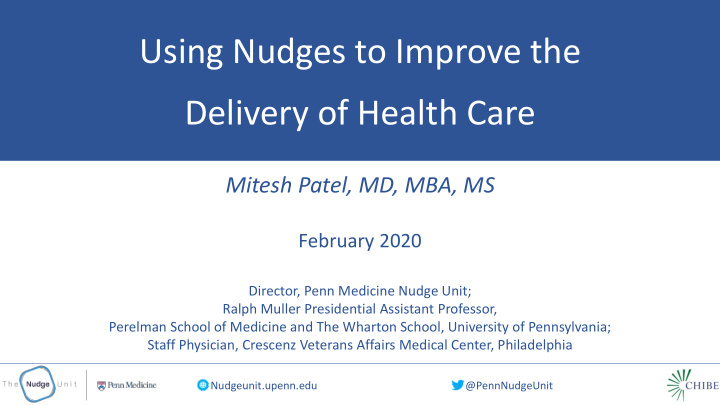



Cardiac rehab referral • Evidence-based pathway – Demonstrated to reduce mortality and readmissions by up to 30% • Referral rates are low – Only 15% of patients at Penn were referred at the time of hospital discharge – More than 25% of hospitals in the US refer less than 20% of their patients
Cardiac rehab referral • Evidence-based pathway – Demonstrated to reduce mortality and readmissions by up to 30% • Referral rates are low – Only 15% of patients at Penn were referred at the time of hospital discharge – More than 25% of hospitals in the US refer less than 20% of their patients • Manual opt-in process – Cardiologists had to complete paper form with 12+ fields while on rounds – Patients had to identify a rehab center on their own and check insurance coverage
Redesigned as an opt-out decision pathway
Redesigned as an opt-out decision pathway Automate identification and notification
Redesigned as an opt-out decision pathway Automate identification and notification Restructure rounding and discharge process
Cardiac Rehab Referral Rates Over Time Adusumalli, Patel et al. Under Review
Cardiac Rehab Referral Rates Over Time Adusumalli, Patel et al. Under Review
Cardiac Rehab Referral Rates Over Time Adusumalli, Patel et al. Under Review
Active Choice Framing
Active choice to prompt decision-making • Alternative to relying on the individual to make a decision
Active choice to prompt decision-making • Alternative to relying on the individual to make a decision • Individual is stopped from proceeding unless they make a choice between options (Yes or No)
Active choice to prompt decision-making • Alternative to relying on the individual to make a decision • Individual is stopped from proceeding unless they make a choice between options (Yes or No) • Design – Prompt decision when you have the physician’s attention – Increase saliency of advantages and disadvantages for each option – Make it easy to say yes
Active choice to prompt decision-making • Alternative to relying on the individual to make a decision • Individual is stopped from proceeding unless they make a choice between options (Yes or No) • Design – Prompt decision when you have the physician’s attention – Increase saliency of advantages and disadvantages for each option – Make it easy to say yes
Influenza vaccination rates Patel et al. JGIM. 2017
Influenza vaccination rates Patel et al. JGIM. 2017
Influenza vaccination rates Patel et al. JGIM. 2017
Influenza vaccination rates • Active choice prompt targeted to physicians and medical assistants Patel et al. JGIM. 2017
Influenza vaccination rates • Active choice prompt targeted to physicians and medical assistants • Difference-in-difference analysis – 6.6 percentage point increase (P<.001) – 37.3% relative increase in vaccination rates Patel et al. JGIM. 2017
Influenza vaccination rates • Active choice prompt targeted to physicians and medical assistants • Difference-in-difference analysis – 6.6 percentage point increase (P<.001) – 37.3% relative increase in vaccination rates • Expanded to other primary care practices at Penn Medicine Patel et al. JGIM. 2017
Influenza vaccination rates • Active choice prompt targeted to physicians and medical assistants • Difference-in-difference analysis – 6.6 percentage point increase (P<.001) – 37.3% relative increase in vaccination rates • Expanded to other primary care practices at Penn Medicine – Number of notifications reduced Patel et al. JGIM. 2017
Influenza vaccination rates • Active choice prompt targeted to physicians and medical assistants • Difference-in-difference analysis – 6.6 percentage point increase (P<.001) – 37.3% relative increase in vaccination rates • Expanded to other primary care practices at Penn Medicine – Number of notifications reduced – Redirected to medical assistants to template orders for physicians Patel et al. JGIM. 2017
Influenza vaccination rates after an active choice intervention Kim, Patel et al. JAMA Network Open. 2018
Influenza vaccination rates after an active choice intervention Kim, Patel et al. JAMA Network Open. 2018
Influenza vaccination rates after an active choice intervention Compared to Control Adjusted difference 9.5 percentage points 95% CI: 4.1 – 14.3 P<0.001 Kim, Patel et al. JAMA Network Open. 2018
Nudges for Population Health
Nudges for Population Health 40,000 patients at Penn Medicine meet national guidelines for statin therapy
Nudges for Population Health 40,000 patients at Penn Medicine meet national guidelines for statin therapy Only about 50% have ever been prescribed a statin
Recommend
More recommend